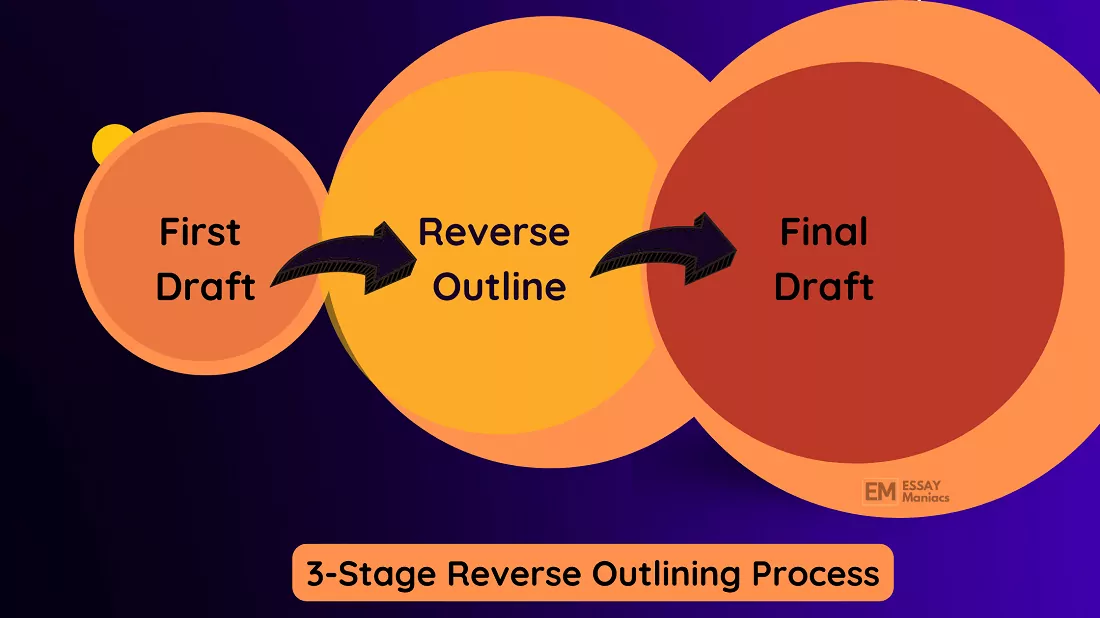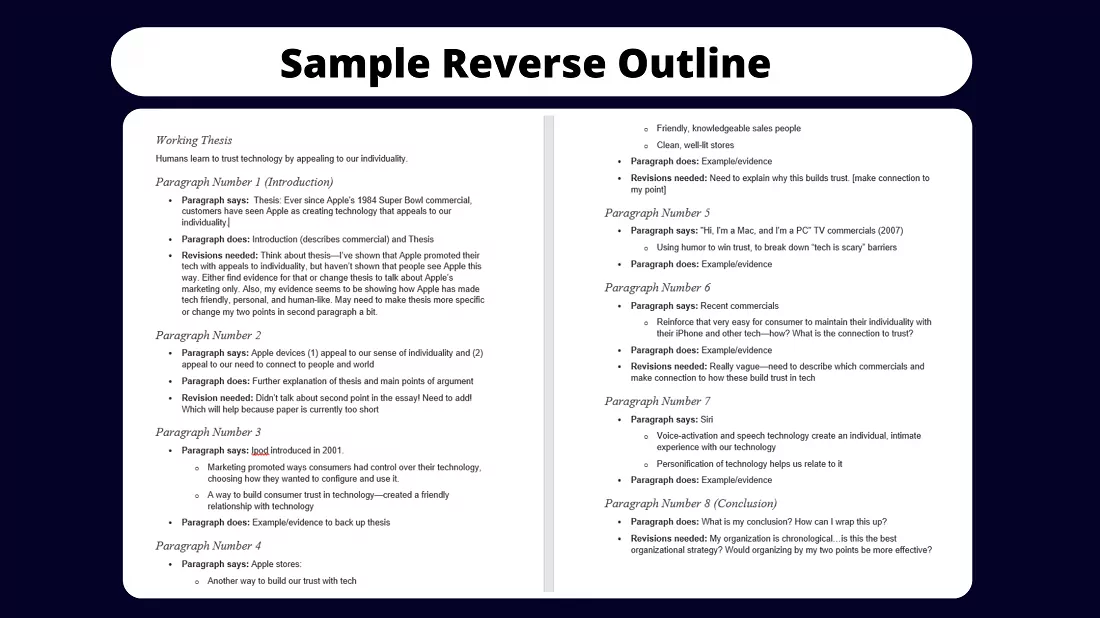
A reverse outline is the ultimate user-friendly revision and structuring tool that can be used for essays, research papers, and other forms of writing.
The process of reverse outlining entails creating an outline based on an already-written draft to assess if there are mistakes and whether the paragraphs have met the goal of your essay. It is a structuring tool that helps reorganize ideas to maintain a good flow of ideas. You can also achieve a balance in your writing as you revise your first draft essay using a reverse outline.
When reverse outlining, begin with the thesis statement in mind. Then, write the skeleton of your paper paragraph by paragraph, and edit as necessary to turn your first draft into a final draft.
If you are wondering what it takes to reverse outline an essay or any piece of writing, this article will take you through everything you need to know to help you learn how to create a reverse outline. We have included tips and examples as necessary. Let's get started!
We have explored the benefits of creating outlines, whether it be for essays, literature reviews, dissertations, theses, and research papers. As we focus on making great reverse outlines, let's first look at the potential benefits you achieve by creating a reverse outline.
When performing a reverse outline, you will go through paragraphs to determine their goals and how that supports the entire document. You will be undertaking a self-marking process.
In the process, you can identify missing sections and wrongly used words and place examples in the proper context. If you have derailed from the original outline, the reverse outline will help you get back on course and achieve the intended goal.
At the same time, you can brainstorm more ideas, expand your approach and evidence, and come up with explanations for the evidence that seems vague. You can also organize thoughts in your essay and ensure a good flow in the paper. For instance, you can check if your paper lacks transitions and add the right ones to fit the context of your writing.
Choosing the ideas to put on paper and those to discard can be challenging. It is the reason why we develop outlines before writing. Most successful students and professionals value the outline, whether formal or informal.
When you have completed your paper, you can create a reverse outline to spot the main ideas in your writing. This way, you can know whether the paper thoroughly answers the essay prompt and meets the assignment instructions (rubric). In addition, you can determine if your topic sentences relate to your thesis statement and whether the supporting ideas and details are correct.
In short, reverse outlining helps you to self-check, self-edit, and revise your paper to meet the higher-score bands. Most students who write high-score essays use reverse outlines.
When exploring ways to lengthen an essay, especially when you are short on words, we intimated that using a reverse outline can help. The main purpose of reverse outlining is to spot issues in a paper, which creates room for revision, polishing, editing, and proofreading.
In terms of revision, it is an editing and revision tool that is simple and takes less time to develop. You can look at the structure of the paragraphs, re-arrange ideas, and refine the weak ideas to make your writing coherent, clear, and complete.
When you have not fulfilled the word count, having a reverse outline can help you know what to add and where to add it without confusing the flow of your paper. If there is any text that dilutes the content, a reverse outline will help you eliminate it.
Reverse outlining effectively works when you have written your essay. For this reason, it can help you to identify the main arguments in the body of your essay, given the thesis statement.
When you identify the arguments, you can refine the angle of analysis or take a different perspective given the context of your writing and the approach you took.
This way, a reverse outline is beneficial in restructuring arguments, claims, and perspectives in an essay so that you can perfect your essay and score better grades.
Far from being used in writing essays and other academic papers, reverse outlining also helps take notes on text (s) as you read.
When asked to write a review, critique, or report on a book, you can use a reverse outline. It will help you to identify the main points, how the points are organized, and the intended goal of the writer.
You can break down large chunks of chapters into small pages of notes, which helps you with revision and internalizing concepts from the book.
When assigned to write an analysis of a short story, a reverse outline can come in handy to help you structure your reaction or responses better.
In the digital age, learning how to create a reverse outline in a word document is indispensable. Although there is no right way to do the reverse outline, you can follow these steps:
When writing the topic sentences and how they advance the overall arguments, use between 5 to 10 words. You should be very brief. Follow the logic of the essay to identify if your writing flows. The note you take should help you quickly identify the changes to be made, spot your main ideas, and visualize the entire paper.
Related: Dissertation literature review guide.
Here are some tips if you are reverse outlining for the first time.
If you intend to revise your essay and get the assurance that it will score higher grades, begin by writing the first draft of your essay.
When writing an essay, you usually focus on writing first and editing later. However, creating a reverse outline while ideas are fresh in your head is easy. Therefore, only begin the reverse outlining process a few minutes after writing your essay.
If you are to revise based on the reverse outline, allow yourself some time to cool off the writing tempo and develop an objective mind.
When creating a reverse outline, you intend to identify whether your written piece meets its intended purpose or goal. One way of doing that is by listing the working thesis at the beginning.
With the thesis in mind, you can perform various actions on your essay's introduction, body, and concluding paragraphs.
An excellent reverse outline begins by listing the working thesis and indicating if it needs reworking based on the direction of the entire essay.
Although you can use your essay's margins to create a reverse outline, working on an entirely new page gives you room to make notes. The notes are for your consumption, and you can make as many notes as you want, provided your reverse outline does its intended purpose.
Professors and instructors will not ask to see your reverse outline. Therefore, you must develop your code or numbering approach when making a reverse outline.
Since a reverse outline represents the key ideas in the essay draft, you can summarize the ideas by numbering the paragraphs. You can use numerical, alphanumerical, or Roman numbering systems.
You are also allowed to use symbols and phrases, provided you maintain the focus on constructing a reverse outline. After all, editing your essay or written piece is for personal use.
If you notice a paragraph is clogged with ideas, try to break it down into two or more. As you do that, think about the idea you want to keep and wish to discard. And when there is no idea how a paragraph came to be, assess whether it sits well with the topic, title, and thesis statement.
A reverse outline should not be as detailed as a typical outline. Instead, you can write the topic sentences in the paragraphs, a summary of the paragraph's purpose, and whether the paragraph needs restructuring or revision and in what direction. Then, in the final draft, you apply these recommendations to ensure each paragraph sits well with your paper's thesis and gist.
Remember, you are not writing another draft, just ideas, and points to help you refine your first draft into a final one.
You should use between 5 and 10 words per paragraph to summarize the ideas and recommend revision. But, again, being brief guarantees easier analysis and editing.
Moving from topic to topic or paragraph by paragraph is preferable when reverse outlining. Maintaining a logical direction during its creation process ensures you leave nothing to chance.
The precision achieved by listing ideas in every paragraph guarantees accuracy in presenting facts. Besides, you can find related problems and develop ways to solve them together without interfering with the flow.
List the remedies or revisions you need to do and what that achieves. Doing so, you also achieve a logical flow in your final draft, which is important for the markers and readers.
A reverse outline is a diagnosis tool. Moreover, it is for your own consumption. If it is messy, do not worry. You need to use it to identify the problems with your writing so that you can realign ideas, cut some, and make sense through your words.
Once you start writing your reverse outline, focus on writing it to complete it. Like writing and editing later, reverse outline first, then edit later. You want to ensure that all the bells and whistles of your paper fit together. The only way is to complete the reverse outline and then take a break before resuming to revise and polish your essay.
As you write a reverse outline, here are some questions that can help you out:
If you notice content and technical discrepancies in your skeletal outline, revise your paper accordingly to achieve excellent grades when you submit the paper.
below is a reverse outline example adopted from a scholarly website.

Once you are done creating a reverse outline, here are some tips to help you diagnose the stylistic, structural, and technical errors and mistakes in your essay. Using these tips, you can identify problems with your arguments, flow, balance, and organization. There are many ways to use the tool for revision.
A once weaker essay can become a masterpiece with thorough editing and re-writing based on a reversed outline.
Reverse outlining is the exact opposite of writing an outline. It comes after you write your first draft but want to improve it. Of course, you can also do a reverse outline when reading a text, but that's not the focus of this guide.
It is a technical tool that helps you diagnose and fix structural problems and mistakes in your essay or paper. In addition, you can successfully self-edit your essay and other academic papers by constructing a reverse outline of your first draft.
There is no one way of doing it better; thus, no need for a reverse outline template. As long as you follow the tips we have shared here, you are set to create better reverse outlines that will strengthen your written arguments, flow of ideas, and structure of essays. You can do it more than once if you wish, especially if you have made changes and want to assess how perfectly they sit with the gist of your paper.
Now that you are in the know, you can alternatively work with our assignment writing geeks. Our essay pros will craft a comprehensive essay that is edited using a reverse outline so that it does not trouble you to create one. We also offer paper shortening and lengthening services, which rely on creating reverse outlines. Expect high-quality essays delivered within your chosen deadlines.

Our papers are 100% original and unique to pass online plagiarism checkers.

Even when we say essays for sale, they meet academic writing conventions.

Hit us up on live chat or Messenger for continuous help with your essays.

Order essays and begin communicating with your writer directly and anonymously.